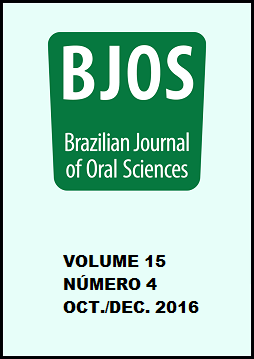Abstract
Aim: To assess the influence of aesthetic surface coating on load-deflection ratios in nickel-titanium (NiTi) orthodontic wires compared with uncoated wires.Methods: NiTi wires (0.016") from four different manufacturers (Morelli, Sorocaba, SP, Brazil; TP, La Porte, IN, USA; Eurodonto, Curitiba, PR, Brazil; Ortho Organizers, San Marcos, CA, USA) were divided into eight groups, according to presence or absence of coating: group 1, Morelli coated wire; group 2, Morelli uncoated; group 3, TP coated; group 4, TP uncoated; group 5, Eurodonto coated; group 6, Eurodonto uncoated; group 7, Ortho Organizers coated; group 8, Ortho Organizers uncoated. To determine the load-deflection ratio, a three-point bending test was performed in a AGS-X 250 KN (Shimadzu) universal testing machine.Results: The results showed that aesthetic coatings did not influence load-deflection ratio in NiTi orthodontic wires at 1-mm and 2-mm activation. However, comparison across the four tested brands revealed that Eurodonto coated wires exhibited the greatest force levels at 1-mm, 2-mm, and 3-mm deflection. At 3-mm deflection, Ortho Organizers coated wires exhibited lower force levels than all other tested brands, except for TP wires.Conclusions: We conclude that the load-deflection ratio of NiTi wires was not influenced significantly by aesthetic coatings, especially at lower activations.References
Zhang M, McGrath C, Hagg U. Patients' expectations and experiences of fixed orthodontic appliance therapy. Impact on quality of life. Angle Orthod. 2007 Mar;77(2):318-22.
Alavi S, Hosseini N. Load-deflection and surface properties of coated and conventional superelastic orthodontic archwires in conventional and metal-insert ceramic brackets. Dent Res J (Isfahan). 2012 Mar;9(2):1338.
Washington B, Evans CA, Viana G, Bedran-Russo A, Megremis S. Contemporary esthetic nickel-titanium wires: do they deliver the same forces? Angle Orthod. 2015 Jan;85(1):95-101. doi: 10.2319/092513701.1.
Russell JS. Aesthetic orthodontic brackets. J Orthod. 2005 Jun;32(2):14663.
Aksakalli S, Malkoc S. Esthetic orthodontic archwires: literature review. J Orthod Res. 2013;1(1):2-4.
Husmann P, Bourauel C, Wessinger M, Jager A. The frictional behavior of coated guiding archwires. J Orofac Orthop. 2002 May;63(3):199-211.
Brunharo IHVP, Quintão KCA. Fios ortodônticos: indicação e aplicação clínica. ln: Ortodontia em um contexto multidisciplinar. Maringá: Dental Press; 2013. p.184-203.
Ramadan AA. Removing hepatitis C virus from polytetrafluoroethylenecoated orthodontic archwires and other dental instruments. East Mediterr Health J. 2003 May;9(3):274-8.
Rock WP, Wilson HJ. Forces exerted by orthodontic aligning archwires. Br J Orthod. 1988 Nov;15(4):255-9.
Krishnan M, Seema S, Kumar AV, Varthini NP, Sukumaran K, Pawar VR et al. Corrosion resistance of surface modified nickel titanium archwires. Angle Orthod. 2014 Mar;84(2):358-67. doi: 10.2319/021813-140.1.
Choi S, Park DJ, Kim KA, Park KH, Park HK, Park YG. In vitro slidingdriven morphological changes in representative esthetic NiTi archwire surfaces. Microsc Res Tech. 2015 Oct;78(10):926-34. doi: 10.1002/ jemt.22557.
Farronato G, Maijer R, Caria MP, Esposito L, Alberzoni D, Cacciatore G. The effect of Teflon coating on the resistance to sliding of orthodontic archwires. Eur J Orthod. 2012 Aug;34(4):410-7. doi: 10.1093/ejo/cjr011.
Neves MG, Almeida FAC, Lima FVP, Brandão GAM, Bramante FS, Gurgel JA. [Comparative study of load/deflection property between regular nickel-titanium wires and aesthetic wires]. Ortho Sci Orthod Sci Pract. 2013;6(24):473-77. Portuguese.
Kim Y, Cha JY, Hwang CJ, Yu HS, Tahk SG. Comparison of frictional forces between aesthetic orthodontic coated wires and self-ligation brackets. 2014 Jul;44(4):157-67. doi: 10.4041/kjod.2014.44.4.157.
Raji SH, Shojaei H, Ghorani PS, Rafiei E. Bacterial colonization on coated and uncoated orthodontic wires: A prospective clinical trial. Dent Res J (Isfahan). 2014 Nov;11(6):680-3.
Neumann P, Bourauel C, Jäger A. Corrosion and permanent fracture resistance of coated and conventional orthodontic wires. J Mater Sci Mater Med. 2002 Feb;13(2):141-7.
Elayyan F, Silikas N, Bearn D. Ex vivo surface and mechanical properties of coated orthodontic archwires. Eur J Orthod. 2008 Dec;30(6):661-7. doi: 10.1093/ejo/cjn057.
Bandeira AM, dos Santos MP, Pulitini G, Elias CN, da Costa MF. Influence of thermal or chemical degradation on the frictional force of an experimental coated NiTi wire. Angle Orthod. 2011 May;81(3):484-9. doi: 10.2319/042810-232.1.
Zegan G, Sodor A, Munteanu C. Surface characteristics of retrieved coated and nickel-titanium orthodontic archwires. Rom J Morphol Embryol. 2012;53(4):935-9.
Silva DL, Mattos CT, Sant' Anna EF, Ruellas AC, Elias CN. Crosssection dimensions and mechanical properties of esthetic orthodontic coated archwires. Am J Orthod Dentofacial Orthop. 2013 Apr;143(4 Suppl):S85-91. doi: 10.1016/j.ajodo.2012.09.009.
Bradley TG, Berzins DW, Valeri N, Pruszynski J, Eliades T, Katsaros C. An investigation into the mechanical and aesthetic properties of new generation coated nickel-titanium wires in the as-received state and after clinical use. Eur J Orthod. 2014 Jun;36(3):290-6. doi: 10.1093/ejo/cjt048.
Rongo R, Ametrano G, Gloria A, Spagnuolo G, Galeotti A, Paduano S, et al. Effects of intraoral aging on surface properties of coated nickel-titanium archwires. Angle Orthod. 2014 Jul;84(4):665-72. doi: 10.2319/081213-593.1
Elayyan F, Silikas N, Bearn D. Mechanical properties of coated superelastic archwires in conventional and self-ligating orthodontic brackets. Am J Orthod Dentofacial Orthop. 2010 Feb;137(2):213-7. doi: 10.1016/j.ajodo.2008.01.026.
Kapila S, Sachdeva R. Mechanical properties and clinical applications of orthodontic wires. Am J Orthod Dentofacial Orthop. 1989 Aug;96(2):1009.
Krishnan V, Kumar KJ. Mechanical properties and surface characteristics of three archwire alloys. Angle Orthod. 2004 Dec;74(6):825-31.
Yoneyama T, Doi H, Hamanaka H, Okamoto Y, Mogi M, Miura F. Superelasticity and thermal behavior of Ni-Ti alloy orthodontic arch wires. Dent Mater J. 1992 Jun;11(1):1-10.
Parvizi F, Rock WP. The load/deflection characteristics of thermally activated orthodontic archwires. Eur J Orthod. 2003 Aug;25(4):417-21.
Kaphoor AA, Sundareswaran S. Aesthetic nickel titanium wires--how much do they deliver? Eur J Orthod. 2012 Oct;34(5):603-9.
Ryu SH, Lim BS, Kwak EJ, Lee GJ, Choi S, Park KH. Surface ultrastructure and mechanical properties of three different white-coated NiTi archwires. Scanning. 2015 Nov-Dec;37(6):414-21. doi: 10.1002/ sca.21230.
Silva DL, Mattos CT, de Araujo MV, de Oliveira Ruellas AC. Color stability and fluorescence of different orthodontic esthetic archwires. Angle Orthod. 2013 Jan;83(1):127-32. doi: 10.2319/121311-764.1.
The Brazilian Journal of Oral Sciences uses the Creative Commons license (CC), thus preserving the integrity of the articles in an open access environment.

